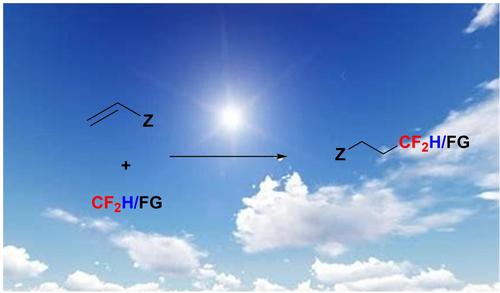当前位置:
X-MOL 学术
›
Chem. Rec.
›
论文详情
Our official English website, www.x-mol.net, welcomes your
feedback! (Note: you will need to create a separate account there.)
Progress in Visible Light‐Induced Difluroalkylation of Olefins
The Chemical Record ( IF 7.0 ) Pub Date : 2020-10-27 , DOI: 10.1002/tcr.202000094 Ronibala Devi Laishram 1 , Jingchao Chen 1 , Baomin Fan 1, 2
The Chemical Record ( IF 7.0 ) Pub Date : 2020-10-27 , DOI: 10.1002/tcr.202000094 Ronibala Devi Laishram 1 , Jingchao Chen 1 , Baomin Fan 1, 2
Affiliation

|
The incorporation of difluoromethylated (CF2) moiety into potentially useful parent molecules lead to significant changes in metabolic stability, lipophilicity, and solubility of the molecules. Over the past several years, with the advent of new difluoromethylating reagents, great progress has been made in the development of a protocol for the direct incorporation of the CF2H group into organic molecules. Among them, difluroalkylation induced by visible light has emerged as an efficient strategy over the past few years. In particular, this protocol provides a more sustainable alternative to other traditional radical‐triggered reactions in terms of environment, energy, step‐economy, health, and safety. The present review mainly focuses on the development of the photocatalytic difluoroalkylation to olefinic moiety using transition‐metal complexes, organic dyes as the photocatalyst; and some organic compounds as a medium of photocatalysis.
中文翻译:

可见光诱导的烯烃二氟烷基化研究进展
将二氟甲基化的(CF 2)部分掺入潜在有用的母体分子中会导致分子的代谢稳定性,亲脂性和溶解性发生重大变化。在过去的几年中,随着新的二氟甲基化试剂的出现,在直接引入CF 2的方案的开发方面取得了巨大的进步。H基团变成有机分子。其中,由可见光诱导的二氟烷基化在过去几年中已成为一种有效的策略。特别是,在环境,能源,阶梯经济,健康和安全性方面,该协议为其他传统的激进式反应提供了更可持续的替代方法。本综述主要集中在使用过渡金属配合物,有机染料作为光催化剂将光催化二氟烷基化发展为烯烃部分的研究。以及一些有机化合物作为光催化介质。
更新日期:2020-10-27
中文翻译:

可见光诱导的烯烃二氟烷基化研究进展
将二氟甲基化的(CF 2)部分掺入潜在有用的母体分子中会导致分子的代谢稳定性,亲脂性和溶解性发生重大变化。在过去的几年中,随着新的二氟甲基化试剂的出现,在直接引入CF 2的方案的开发方面取得了巨大的进步。H基团变成有机分子。其中,由可见光诱导的二氟烷基化在过去几年中已成为一种有效的策略。特别是,在环境,能源,阶梯经济,健康和安全性方面,该协议为其他传统的激进式反应提供了更可持续的替代方法。本综述主要集中在使用过渡金属配合物,有机染料作为光催化剂将光催化二氟烷基化发展为烯烃部分的研究。以及一些有机化合物作为光催化介质。











































 京公网安备 11010802027423号
京公网安备 11010802027423号